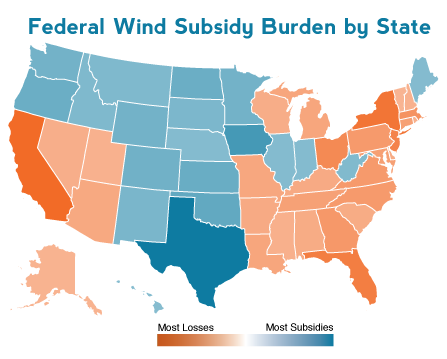IER Report Details the Distributional Impact of Federal Wind Subsidies
WASHINGTON – Today, the Institute for Energy Research released the most comprehensive study to date of the impacts of federal wind subsidies across all U.S. states. IER analysts found that from 2005 to 2014, the cumulative subsidy allocations from the PTC, ITC, and Section 1603 to the wind industry are at least $18.58 billion.
The study also found that over the last decade, taxpayers in 30 states and the District of Columbia paid more in taxes to the federal government to support wind subsidies than wind producers who own wind facilities in those states received in subsidy allocations.
Although the report discusses states and regions in terms of net losses and net subsidies to show the geographical distribution of federal wind subsidies, we note that the ultimate recipients are actually the owners of wind facilities, while losses accrue to all Americans who pay federal taxes. In other words, subsidies to wind producers come at the expense of all U.S. taxpayers.
Other key findings include:
- Over the last decade, the top-five states with the most net losses are California, New York, Florida, New Jersey, and Ohio. These states combined paid upwards of $4.81 billion more to support federal wind subsidies than wind producers in those states received in subsidy payments.
- States in the Southeast paid, in total, $3.66 billion on net to support federal wind subsidies.
- Florida, which does not generate electricity from wind power, has suffered the third most net losses of any state at over $920 million.
- States in the Northeast paid, in total, $3.87 billion on net to support federal wind subsidies.
- Wind producers in 8 out of 12 Midwestern states received more federal wind subsidies than taxpayers in those states contributed to their share of the wind subsidy tax burden.
- Taxpayers in Ohio, the state that suffered the fifth most net losses, have subsidized wind producers in other states not only through their federal tax dollars, but also through the state RPS—which utilities cannot meet without purchasing electricity from wind producers in neighboring states.
- As a whole, wind producers in the Southwest received nearly $4.00 billion more in federal wind subsidies than taxpayers in their states paid in taxes from 2005 to 2014 to support federal wind subsidies.
- Texas wind producers are the largest net recipients of federal wind subsidies. Wind producers in Texas received $2.998 billion more over the past decade than Texas taxpayers contributed to support federal wind subsidies.
- California had the second highest installed wind capacity in the country and was the sixth largest recipient in terms of gross subsidies, receiving a total of almost $913.2 million in our ten-year snapshot. However, because California taxpayers contribute the largest share of the federal tax burden—almost 12 percent of the total—California actually shoulders the largest net losses of any state at $1.259 billion.
Click here to see the full study.
###




